Assessing the UN's Anti-Trafficking Initiatives in Asia
VerifiedAdded on 2023/01/23
|85
|20701
|62
Report
AI Summary
This research paper examines the complex issue of human trafficking in Asia and evaluates the effectiveness of the United Nations' (UN) efforts to combat it. The study begins with an introduction to human trafficking, its various forms (labor, sex, and war slavery), and the increasing prevalence in the Asian region, particularly among vulnerable populations like children and women. The paper delves into the background of the problem, highlighting its historical roots and the role of globalization in exacerbating the issue. It explores the UN's Global Action Plan against human trafficking, outlining the strategies and policies implemented to prevent trafficking, protect victims, and prosecute offenders. The research investigates the factors driving human trafficking in Asia, including economic disparities, poverty, and the presence of a highly developed sex tourism industry. The methodology section details the research approach, data collection, and analysis methods employed. The findings reveal that despite UN initiatives, the number of trafficking cases remains high, suggesting limitations in policy effectiveness. The paper concludes by linking the findings with the research objectives, providing recommendations for improving UN policies, and suggesting future research directions. The study aims to contribute to a better understanding of the challenges and potential solutions for combating human trafficking in Asia, offering insights for policymakers and stakeholders.
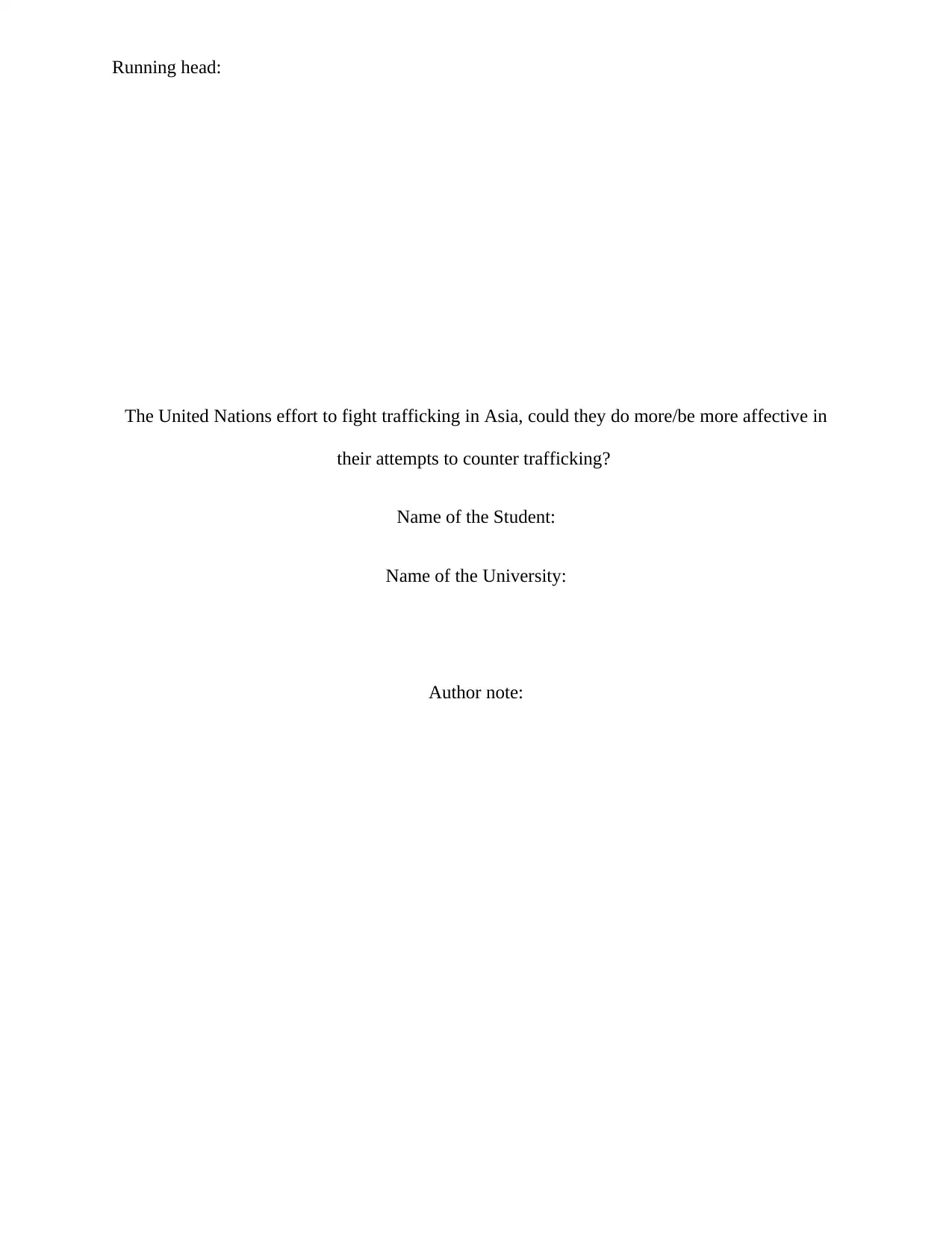
Running head:
The United Nations effort to fight trafficking in Asia, could they do more/be more affective in
their attempts to counter trafficking?
Name of the Student:
Name of the University:
Author note:
The United Nations effort to fight trafficking in Asia, could they do more/be more affective in
their attempts to counter trafficking?
Name of the Student:
Name of the University:
Author note:
Paraphrase This Document
Need a fresh take? Get an instant paraphrase of this document with our AI Paraphraser
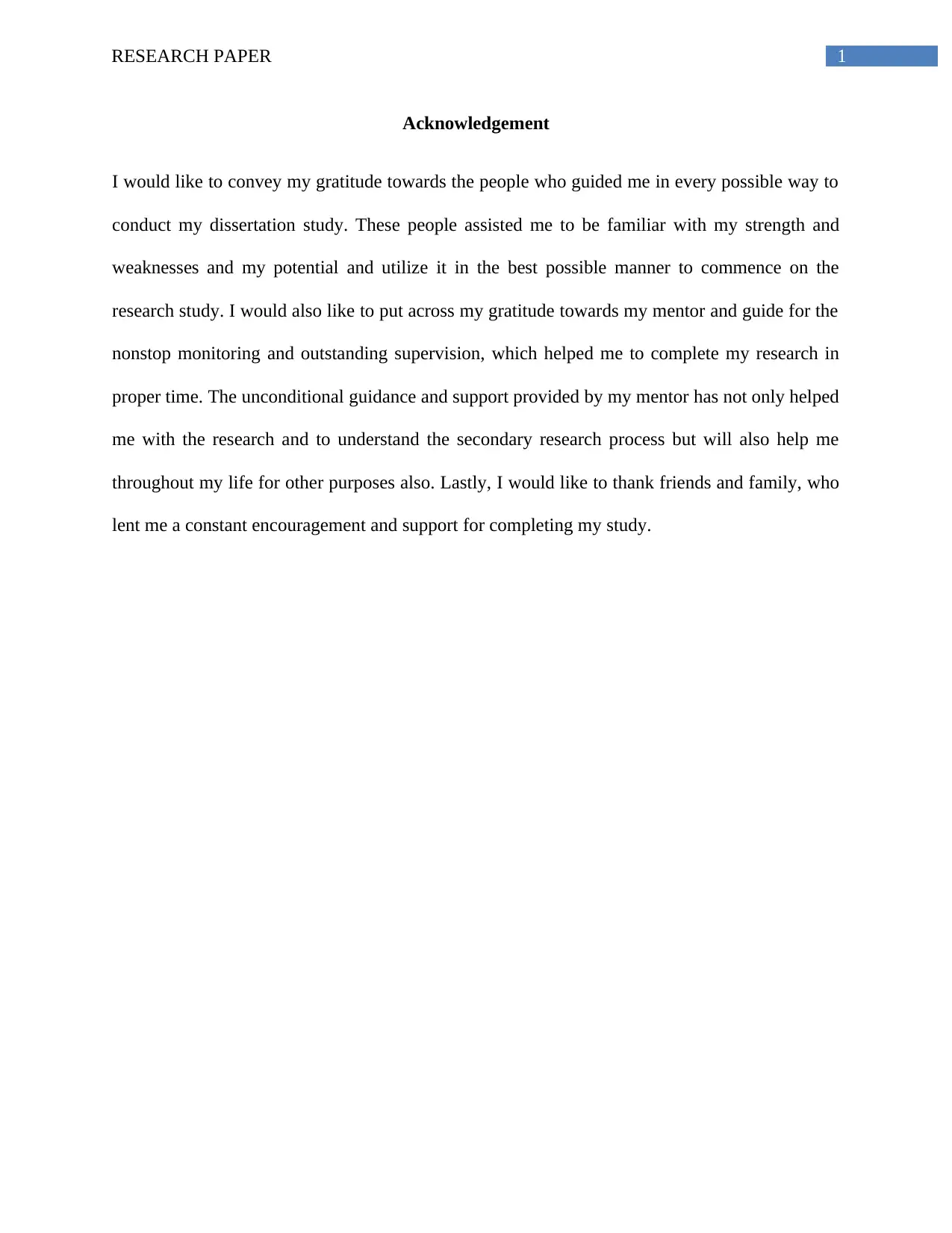
1RESEARCH PAPER
Acknowledgement
I would like to convey my gratitude towards the people who guided me in every possible way to
conduct my dissertation study. These people assisted me to be familiar with my strength and
weaknesses and my potential and utilize it in the best possible manner to commence on the
research study. I would also like to put across my gratitude towards my mentor and guide for the
nonstop monitoring and outstanding supervision, which helped me to complete my research in
proper time. The unconditional guidance and support provided by my mentor has not only helped
me with the research and to understand the secondary research process but will also help me
throughout my life for other purposes also. Lastly, I would like to thank friends and family, who
lent me a constant encouragement and support for completing my study.
Acknowledgement
I would like to convey my gratitude towards the people who guided me in every possible way to
conduct my dissertation study. These people assisted me to be familiar with my strength and
weaknesses and my potential and utilize it in the best possible manner to commence on the
research study. I would also like to put across my gratitude towards my mentor and guide for the
nonstop monitoring and outstanding supervision, which helped me to complete my research in
proper time. The unconditional guidance and support provided by my mentor has not only helped
me with the research and to understand the secondary research process but will also help me
throughout my life for other purposes also. Lastly, I would like to thank friends and family, who
lent me a constant encouragement and support for completing my study.
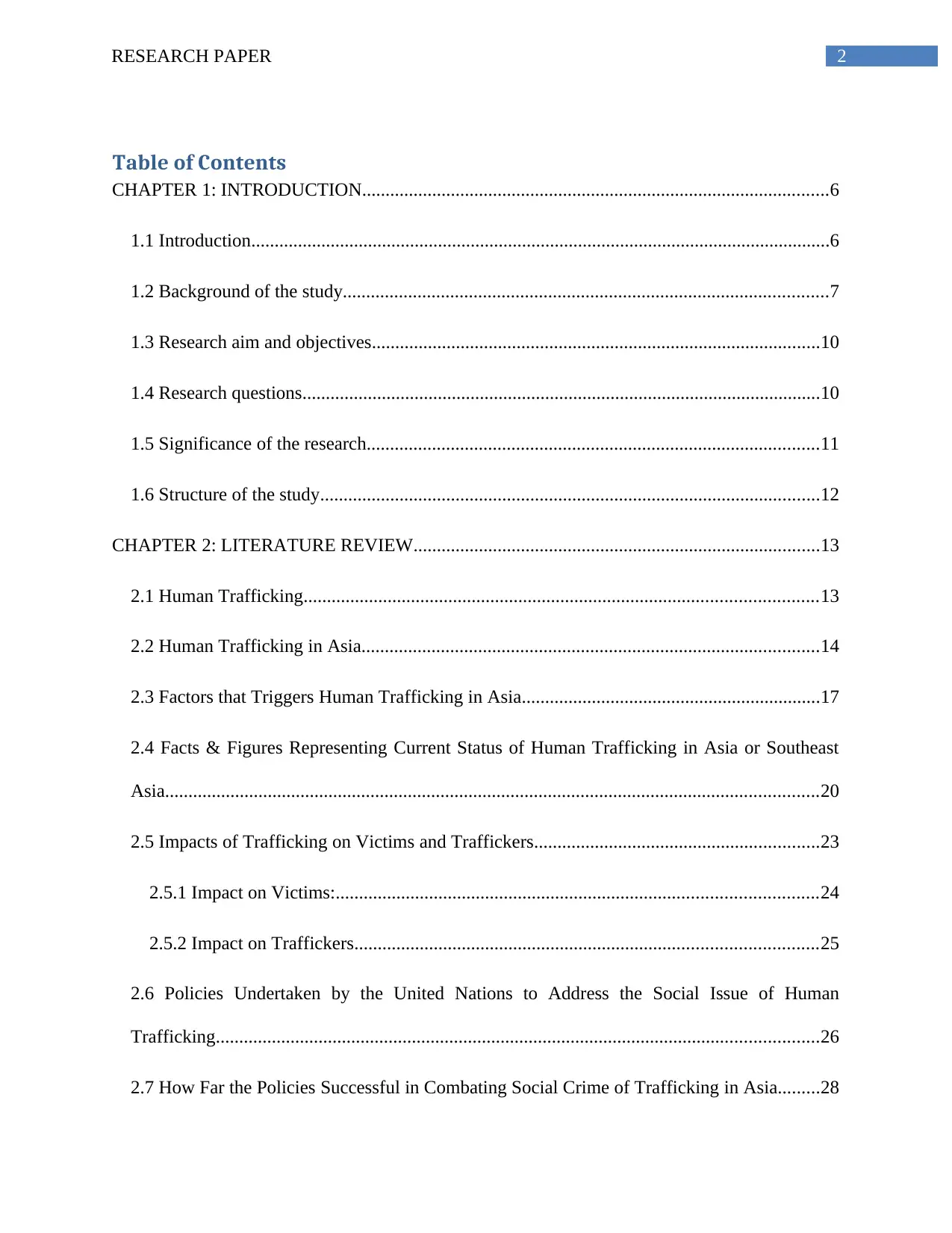
2RESEARCH PAPER
Table of Contents
CHAPTER 1: INTRODUCTION....................................................................................................6
1.1 Introduction............................................................................................................................6
1.2 Background of the study........................................................................................................7
1.3 Research aim and objectives................................................................................................10
1.4 Research questions...............................................................................................................10
1.5 Significance of the research.................................................................................................11
1.6 Structure of the study...........................................................................................................12
CHAPTER 2: LITERATURE REVIEW.......................................................................................13
2.1 Human Trafficking..............................................................................................................13
2.2 Human Trafficking in Asia..................................................................................................14
2.3 Factors that Triggers Human Trafficking in Asia................................................................17
2.4 Facts & Figures Representing Current Status of Human Trafficking in Asia or Southeast
Asia............................................................................................................................................20
2.5 Impacts of Trafficking on Victims and Traffickers.............................................................23
2.5.1 Impact on Victims:.......................................................................................................24
2.5.2 Impact on Traffickers...................................................................................................25
2.6 Policies Undertaken by the United Nations to Address the Social Issue of Human
Trafficking.................................................................................................................................26
2.7 How Far the Policies Successful in Combating Social Crime of Trafficking in Asia.........28
Table of Contents
CHAPTER 1: INTRODUCTION....................................................................................................6
1.1 Introduction............................................................................................................................6
1.2 Background of the study........................................................................................................7
1.3 Research aim and objectives................................................................................................10
1.4 Research questions...............................................................................................................10
1.5 Significance of the research.................................................................................................11
1.6 Structure of the study...........................................................................................................12
CHAPTER 2: LITERATURE REVIEW.......................................................................................13
2.1 Human Trafficking..............................................................................................................13
2.2 Human Trafficking in Asia..................................................................................................14
2.3 Factors that Triggers Human Trafficking in Asia................................................................17
2.4 Facts & Figures Representing Current Status of Human Trafficking in Asia or Southeast
Asia............................................................................................................................................20
2.5 Impacts of Trafficking on Victims and Traffickers.............................................................23
2.5.1 Impact on Victims:.......................................................................................................24
2.5.2 Impact on Traffickers...................................................................................................25
2.6 Policies Undertaken by the United Nations to Address the Social Issue of Human
Trafficking.................................................................................................................................26
2.7 How Far the Policies Successful in Combating Social Crime of Trafficking in Asia.........28
⊘ This is a preview!⊘
Do you want full access?
Subscribe today to unlock all pages.

Trusted by 1+ million students worldwide
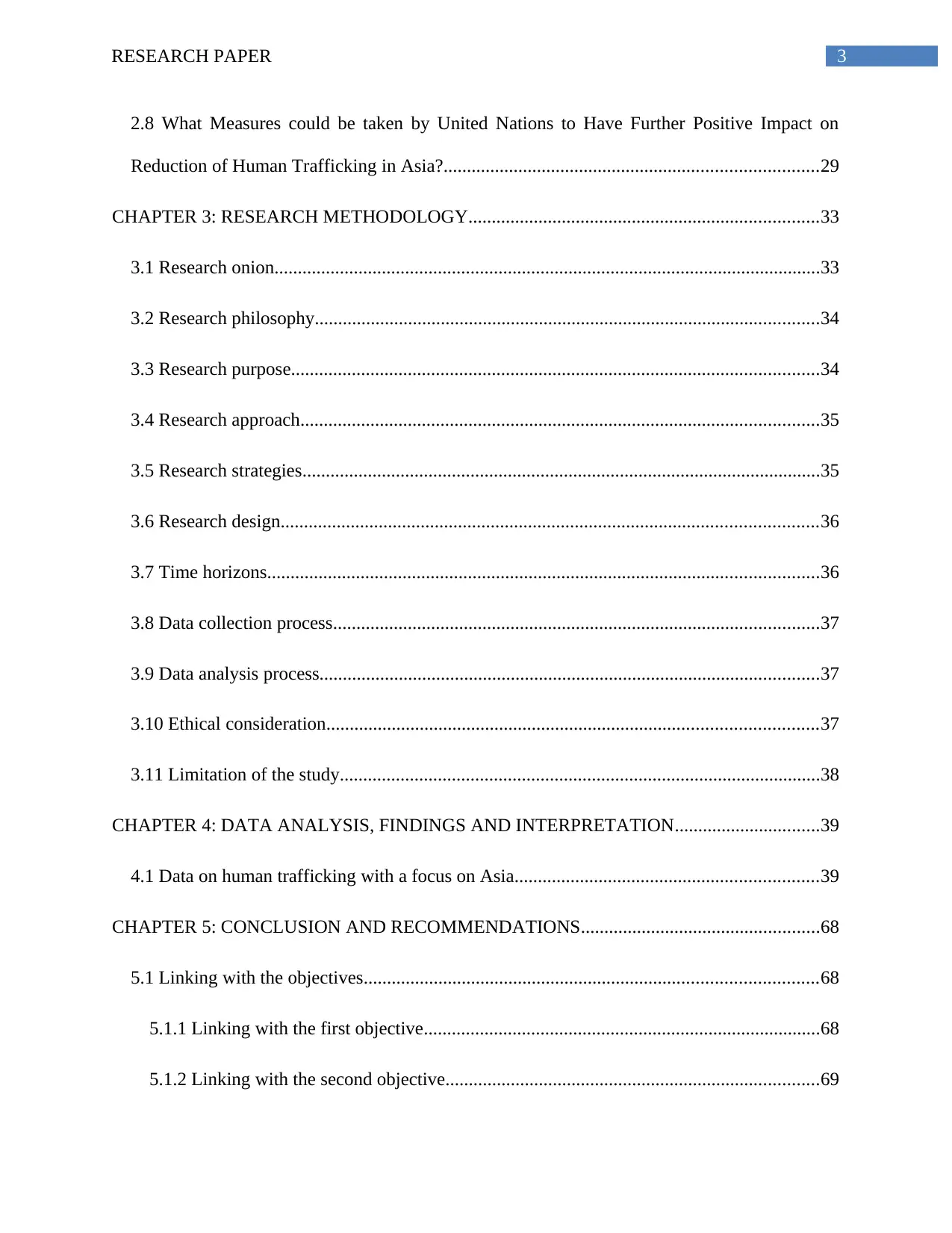
3RESEARCH PAPER
2.8 What Measures could be taken by United Nations to Have Further Positive Impact on
Reduction of Human Trafficking in Asia?................................................................................29
CHAPTER 3: RESEARCH METHODOLOGY...........................................................................33
3.1 Research onion.....................................................................................................................33
3.2 Research philosophy............................................................................................................34
3.3 Research purpose.................................................................................................................34
3.4 Research approach...............................................................................................................35
3.5 Research strategies...............................................................................................................35
3.6 Research design...................................................................................................................36
3.7 Time horizons......................................................................................................................36
3.8 Data collection process........................................................................................................37
3.9 Data analysis process...........................................................................................................37
3.10 Ethical consideration.........................................................................................................37
3.11 Limitation of the study.......................................................................................................38
CHAPTER 4: DATA ANALYSIS, FINDINGS AND INTERPRETATION...............................39
4.1 Data on human trafficking with a focus on Asia.................................................................39
CHAPTER 5: CONCLUSION AND RECOMMENDATIONS...................................................68
5.1 Linking with the objectives.................................................................................................68
5.1.1 Linking with the first objective.....................................................................................68
5.1.2 Linking with the second objective................................................................................69
2.8 What Measures could be taken by United Nations to Have Further Positive Impact on
Reduction of Human Trafficking in Asia?................................................................................29
CHAPTER 3: RESEARCH METHODOLOGY...........................................................................33
3.1 Research onion.....................................................................................................................33
3.2 Research philosophy............................................................................................................34
3.3 Research purpose.................................................................................................................34
3.4 Research approach...............................................................................................................35
3.5 Research strategies...............................................................................................................35
3.6 Research design...................................................................................................................36
3.7 Time horizons......................................................................................................................36
3.8 Data collection process........................................................................................................37
3.9 Data analysis process...........................................................................................................37
3.10 Ethical consideration.........................................................................................................37
3.11 Limitation of the study.......................................................................................................38
CHAPTER 4: DATA ANALYSIS, FINDINGS AND INTERPRETATION...............................39
4.1 Data on human trafficking with a focus on Asia.................................................................39
CHAPTER 5: CONCLUSION AND RECOMMENDATIONS...................................................68
5.1 Linking with the objectives.................................................................................................68
5.1.1 Linking with the first objective.....................................................................................68
5.1.2 Linking with the second objective................................................................................69
Paraphrase This Document
Need a fresh take? Get an instant paraphrase of this document with our AI Paraphraser
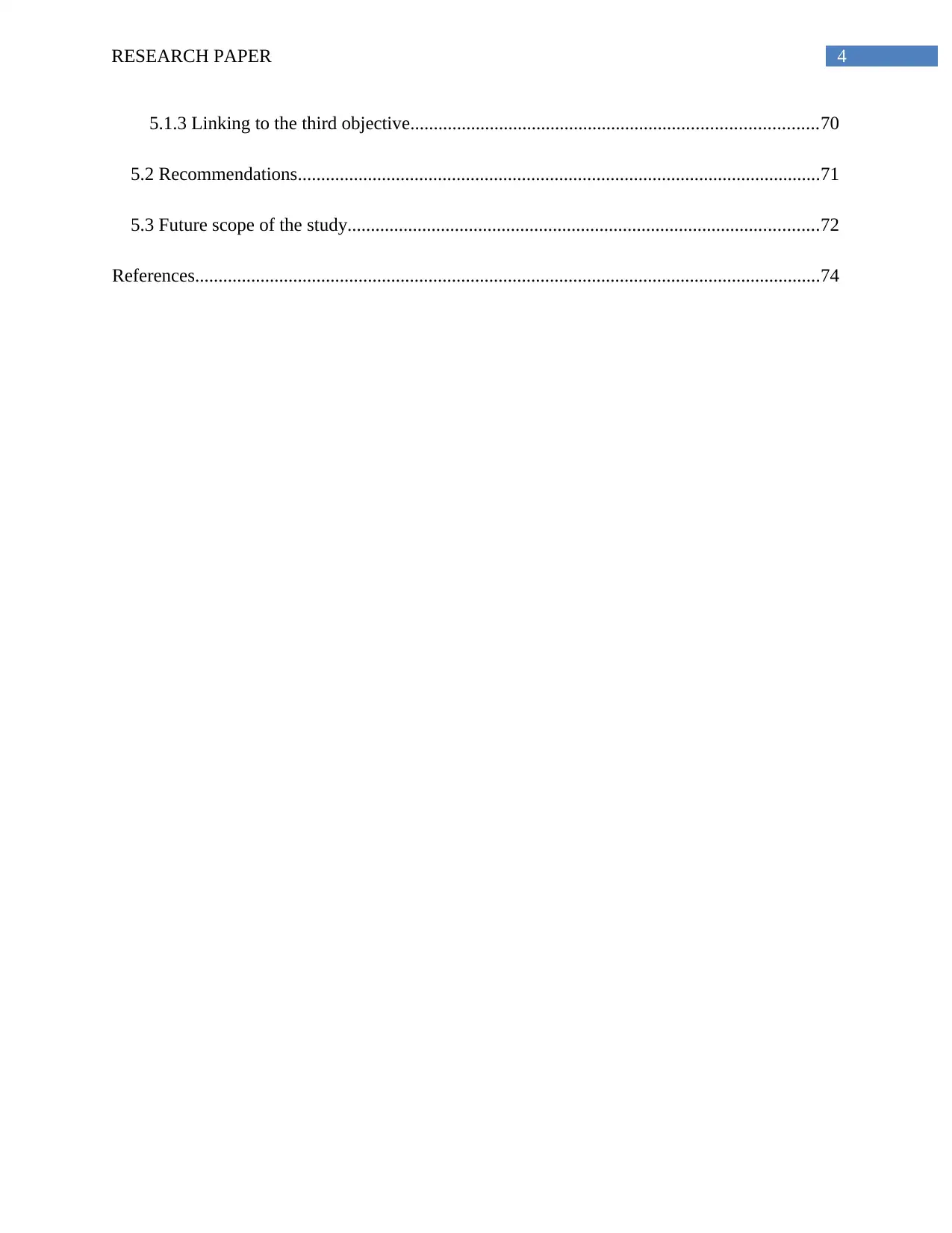
4RESEARCH PAPER
5.1.3 Linking to the third objective.......................................................................................70
5.2 Recommendations................................................................................................................71
5.3 Future scope of the study.....................................................................................................72
References......................................................................................................................................74
5.1.3 Linking to the third objective.......................................................................................70
5.2 Recommendations................................................................................................................71
5.3 Future scope of the study.....................................................................................................72
References......................................................................................................................................74
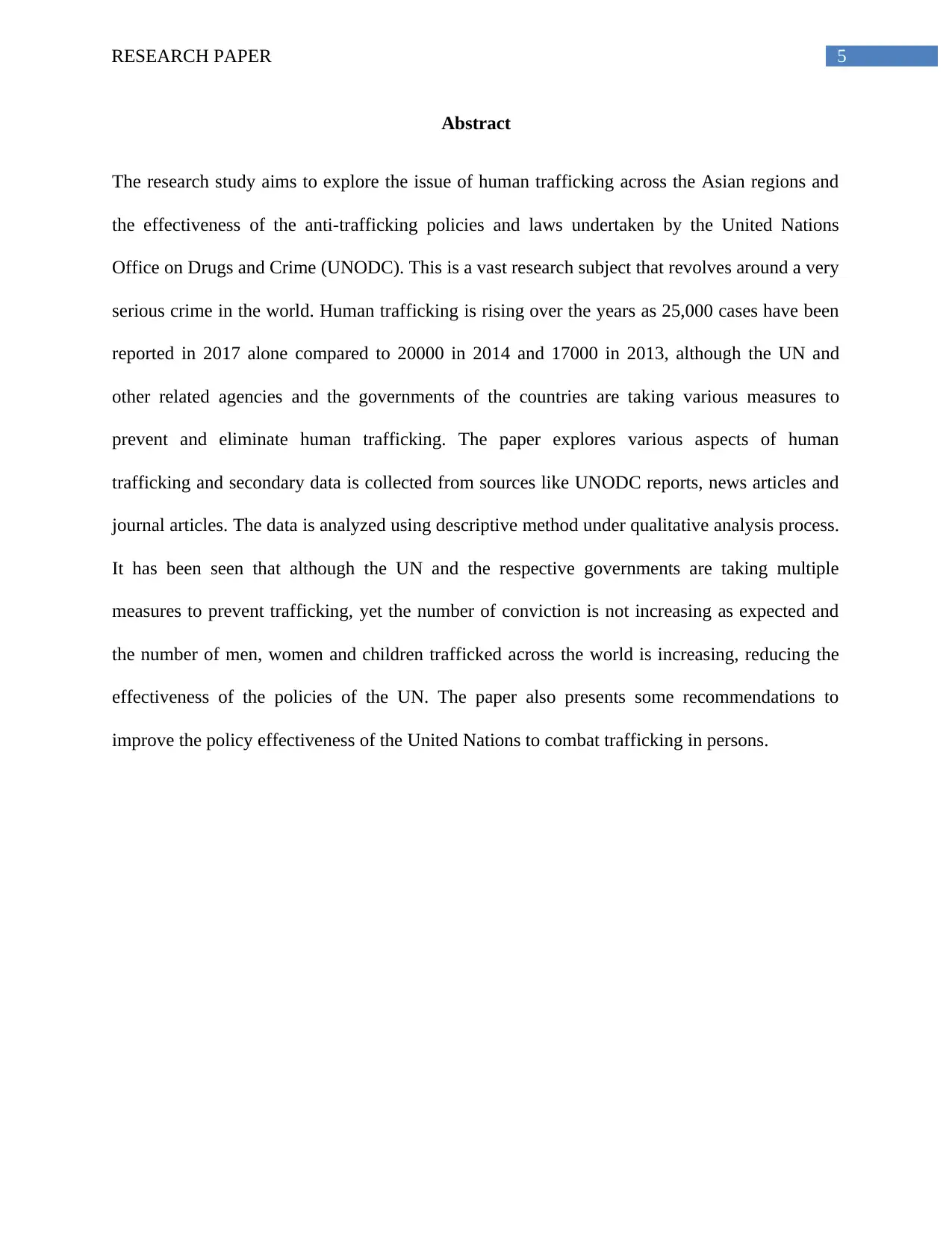
5RESEARCH PAPER
Abstract
The research study aims to explore the issue of human trafficking across the Asian regions and
the effectiveness of the anti-trafficking policies and laws undertaken by the United Nations
Office on Drugs and Crime (UNODC). This is a vast research subject that revolves around a very
serious crime in the world. Human trafficking is rising over the years as 25,000 cases have been
reported in 2017 alone compared to 20000 in 2014 and 17000 in 2013, although the UN and
other related agencies and the governments of the countries are taking various measures to
prevent and eliminate human trafficking. The paper explores various aspects of human
trafficking and secondary data is collected from sources like UNODC reports, news articles and
journal articles. The data is analyzed using descriptive method under qualitative analysis process.
It has been seen that although the UN and the respective governments are taking multiple
measures to prevent trafficking, yet the number of conviction is not increasing as expected and
the number of men, women and children trafficked across the world is increasing, reducing the
effectiveness of the policies of the UN. The paper also presents some recommendations to
improve the policy effectiveness of the United Nations to combat trafficking in persons.
Abstract
The research study aims to explore the issue of human trafficking across the Asian regions and
the effectiveness of the anti-trafficking policies and laws undertaken by the United Nations
Office on Drugs and Crime (UNODC). This is a vast research subject that revolves around a very
serious crime in the world. Human trafficking is rising over the years as 25,000 cases have been
reported in 2017 alone compared to 20000 in 2014 and 17000 in 2013, although the UN and
other related agencies and the governments of the countries are taking various measures to
prevent and eliminate human trafficking. The paper explores various aspects of human
trafficking and secondary data is collected from sources like UNODC reports, news articles and
journal articles. The data is analyzed using descriptive method under qualitative analysis process.
It has been seen that although the UN and the respective governments are taking multiple
measures to prevent trafficking, yet the number of conviction is not increasing as expected and
the number of men, women and children trafficked across the world is increasing, reducing the
effectiveness of the policies of the UN. The paper also presents some recommendations to
improve the policy effectiveness of the United Nations to combat trafficking in persons.
⊘ This is a preview!⊘
Do you want full access?
Subscribe today to unlock all pages.

Trusted by 1+ million students worldwide
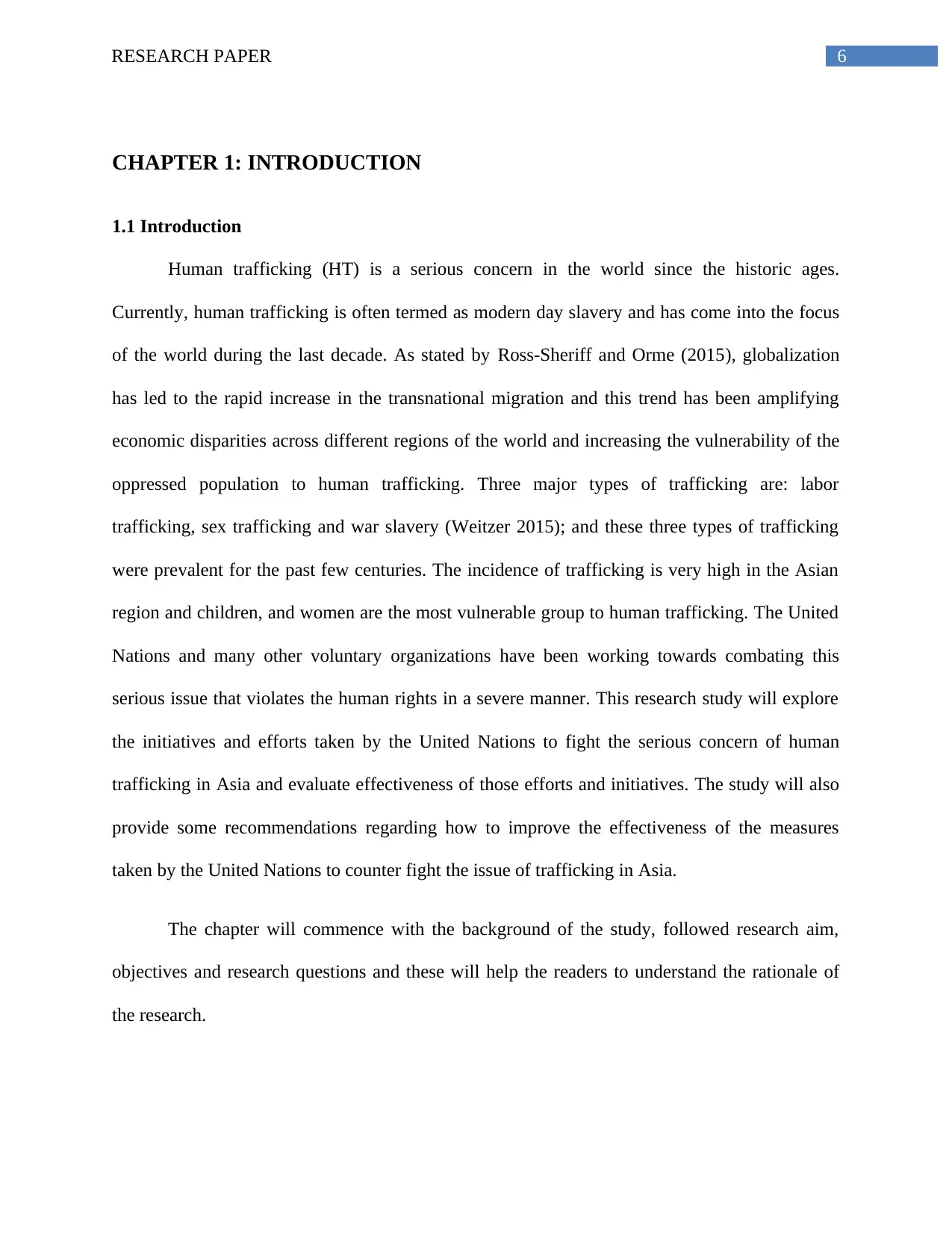
6RESEARCH PAPER
CHAPTER 1: INTRODUCTION
1.1 Introduction
Human trafficking (HT) is a serious concern in the world since the historic ages.
Currently, human trafficking is often termed as modern day slavery and has come into the focus
of the world during the last decade. As stated by Ross-Sheriff and Orme (2015), globalization
has led to the rapid increase in the transnational migration and this trend has been amplifying
economic disparities across different regions of the world and increasing the vulnerability of the
oppressed population to human trafficking. Three major types of trafficking are: labor
trafficking, sex trafficking and war slavery (Weitzer 2015); and these three types of trafficking
were prevalent for the past few centuries. The incidence of trafficking is very high in the Asian
region and children, and women are the most vulnerable group to human trafficking. The United
Nations and many other voluntary organizations have been working towards combating this
serious issue that violates the human rights in a severe manner. This research study will explore
the initiatives and efforts taken by the United Nations to fight the serious concern of human
trafficking in Asia and evaluate effectiveness of those efforts and initiatives. The study will also
provide some recommendations regarding how to improve the effectiveness of the measures
taken by the United Nations to counter fight the issue of trafficking in Asia.
The chapter will commence with the background of the study, followed research aim,
objectives and research questions and these will help the readers to understand the rationale of
the research.
CHAPTER 1: INTRODUCTION
1.1 Introduction
Human trafficking (HT) is a serious concern in the world since the historic ages.
Currently, human trafficking is often termed as modern day slavery and has come into the focus
of the world during the last decade. As stated by Ross-Sheriff and Orme (2015), globalization
has led to the rapid increase in the transnational migration and this trend has been amplifying
economic disparities across different regions of the world and increasing the vulnerability of the
oppressed population to human trafficking. Three major types of trafficking are: labor
trafficking, sex trafficking and war slavery (Weitzer 2015); and these three types of trafficking
were prevalent for the past few centuries. The incidence of trafficking is very high in the Asian
region and children, and women are the most vulnerable group to human trafficking. The United
Nations and many other voluntary organizations have been working towards combating this
serious issue that violates the human rights in a severe manner. This research study will explore
the initiatives and efforts taken by the United Nations to fight the serious concern of human
trafficking in Asia and evaluate effectiveness of those efforts and initiatives. The study will also
provide some recommendations regarding how to improve the effectiveness of the measures
taken by the United Nations to counter fight the issue of trafficking in Asia.
The chapter will commence with the background of the study, followed research aim,
objectives and research questions and these will help the readers to understand the rationale of
the research.
Paraphrase This Document
Need a fresh take? Get an instant paraphrase of this document with our AI Paraphraser
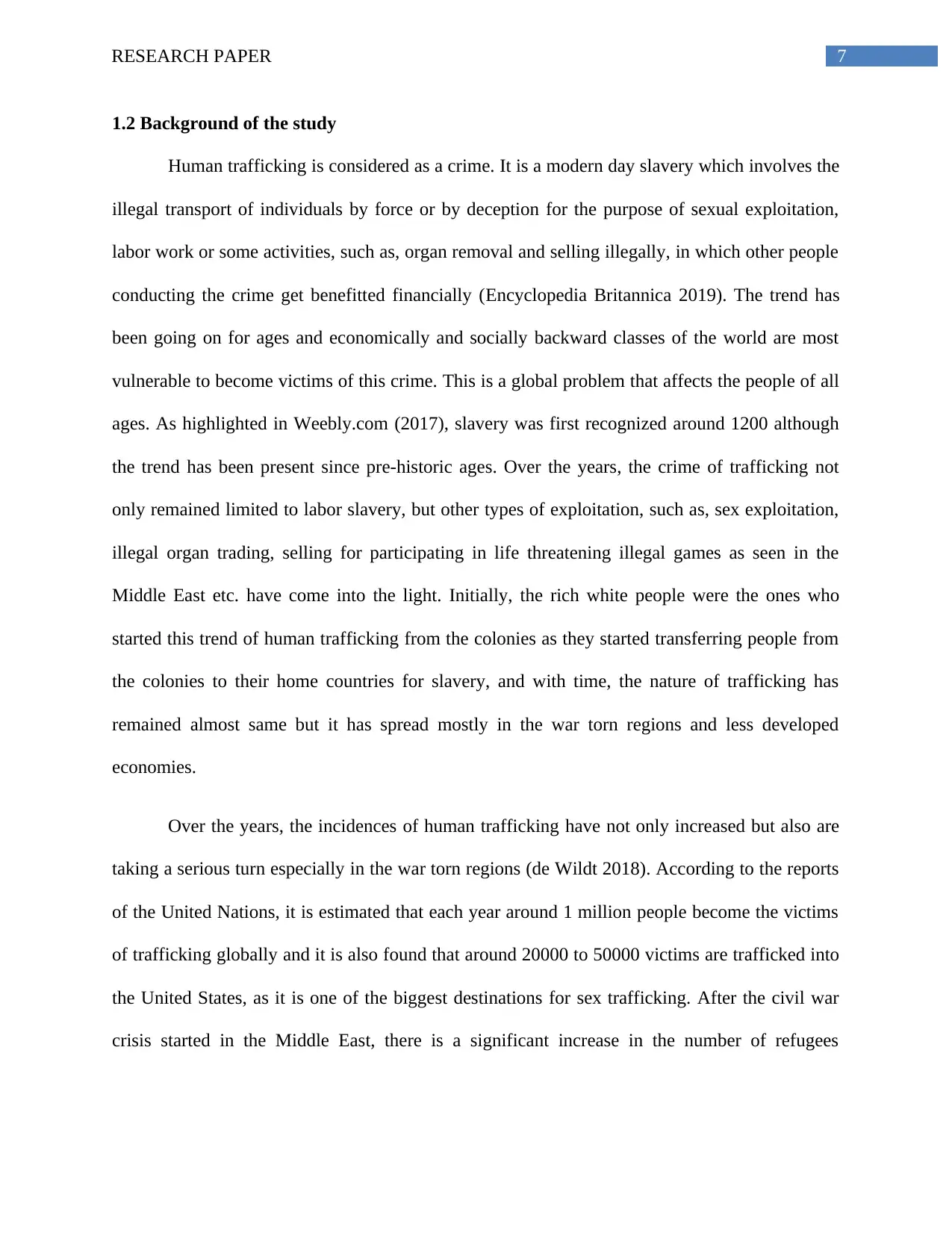
7RESEARCH PAPER
1.2 Background of the study
Human trafficking is considered as a crime. It is a modern day slavery which involves the
illegal transport of individuals by force or by deception for the purpose of sexual exploitation,
labor work or some activities, such as, organ removal and selling illegally, in which other people
conducting the crime get benefitted financially (Encyclopedia Britannica 2019). The trend has
been going on for ages and economically and socially backward classes of the world are most
vulnerable to become victims of this crime. This is a global problem that affects the people of all
ages. As highlighted in Weebly.com (2017), slavery was first recognized around 1200 although
the trend has been present since pre-historic ages. Over the years, the crime of trafficking not
only remained limited to labor slavery, but other types of exploitation, such as, sex exploitation,
illegal organ trading, selling for participating in life threatening illegal games as seen in the
Middle East etc. have come into the light. Initially, the rich white people were the ones who
started this trend of human trafficking from the colonies as they started transferring people from
the colonies to their home countries for slavery, and with time, the nature of trafficking has
remained almost same but it has spread mostly in the war torn regions and less developed
economies.
Over the years, the incidences of human trafficking have not only increased but also are
taking a serious turn especially in the war torn regions (de Wildt 2018). According to the reports
of the United Nations, it is estimated that each year around 1 million people become the victims
of trafficking globally and it is also found that around 20000 to 50000 victims are trafficked into
the United States, as it is one of the biggest destinations for sex trafficking. After the civil war
crisis started in the Middle East, there is a significant increase in the number of refugees
1.2 Background of the study
Human trafficking is considered as a crime. It is a modern day slavery which involves the
illegal transport of individuals by force or by deception for the purpose of sexual exploitation,
labor work or some activities, such as, organ removal and selling illegally, in which other people
conducting the crime get benefitted financially (Encyclopedia Britannica 2019). The trend has
been going on for ages and economically and socially backward classes of the world are most
vulnerable to become victims of this crime. This is a global problem that affects the people of all
ages. As highlighted in Weebly.com (2017), slavery was first recognized around 1200 although
the trend has been present since pre-historic ages. Over the years, the crime of trafficking not
only remained limited to labor slavery, but other types of exploitation, such as, sex exploitation,
illegal organ trading, selling for participating in life threatening illegal games as seen in the
Middle East etc. have come into the light. Initially, the rich white people were the ones who
started this trend of human trafficking from the colonies as they started transferring people from
the colonies to their home countries for slavery, and with time, the nature of trafficking has
remained almost same but it has spread mostly in the war torn regions and less developed
economies.
Over the years, the incidences of human trafficking have not only increased but also are
taking a serious turn especially in the war torn regions (de Wildt 2018). According to the reports
of the United Nations, it is estimated that each year around 1 million people become the victims
of trafficking globally and it is also found that around 20000 to 50000 victims are trafficked into
the United States, as it is one of the biggest destinations for sex trafficking. After the civil war
crisis started in the Middle East, there is a significant increase in the number of refugees
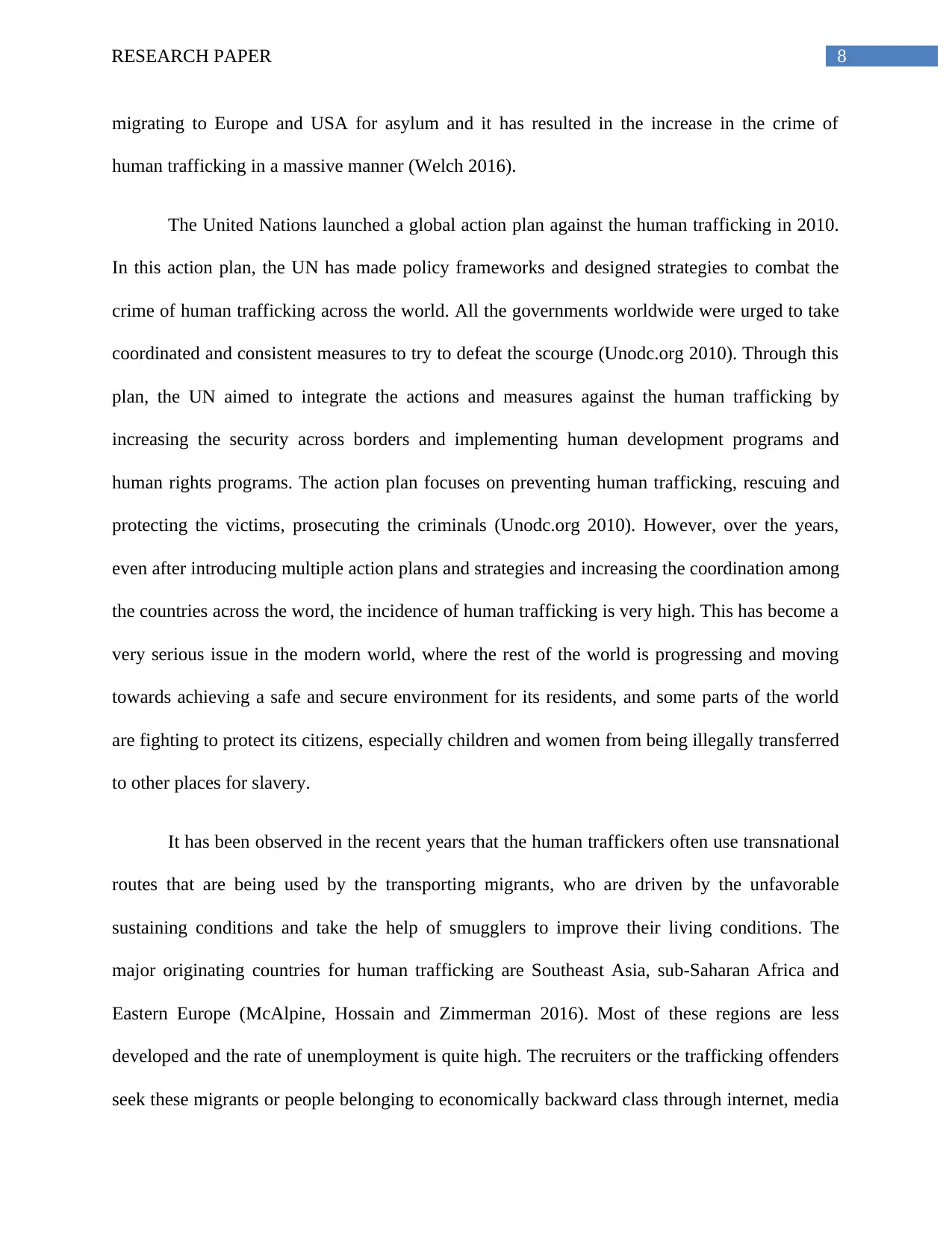
8RESEARCH PAPER
migrating to Europe and USA for asylum and it has resulted in the increase in the crime of
human trafficking in a massive manner (Welch 2016).
The United Nations launched a global action plan against the human trafficking in 2010.
In this action plan, the UN has made policy frameworks and designed strategies to combat the
crime of human trafficking across the world. All the governments worldwide were urged to take
coordinated and consistent measures to try to defeat the scourge (Unodc.org 2010). Through this
plan, the UN aimed to integrate the actions and measures against the human trafficking by
increasing the security across borders and implementing human development programs and
human rights programs. The action plan focuses on preventing human trafficking, rescuing and
protecting the victims, prosecuting the criminals (Unodc.org 2010). However, over the years,
even after introducing multiple action plans and strategies and increasing the coordination among
the countries across the word, the incidence of human trafficking is very high. This has become a
very serious issue in the modern world, where the rest of the world is progressing and moving
towards achieving a safe and secure environment for its residents, and some parts of the world
are fighting to protect its citizens, especially children and women from being illegally transferred
to other places for slavery.
It has been observed in the recent years that the human traffickers often use transnational
routes that are being used by the transporting migrants, who are driven by the unfavorable
sustaining conditions and take the help of smugglers to improve their living conditions. The
major originating countries for human trafficking are Southeast Asia, sub-Saharan Africa and
Eastern Europe (McAlpine, Hossain and Zimmerman 2016). Most of these regions are less
developed and the rate of unemployment is quite high. The recruiters or the trafficking offenders
seek these migrants or people belonging to economically backward class through internet, media
migrating to Europe and USA for asylum and it has resulted in the increase in the crime of
human trafficking in a massive manner (Welch 2016).
The United Nations launched a global action plan against the human trafficking in 2010.
In this action plan, the UN has made policy frameworks and designed strategies to combat the
crime of human trafficking across the world. All the governments worldwide were urged to take
coordinated and consistent measures to try to defeat the scourge (Unodc.org 2010). Through this
plan, the UN aimed to integrate the actions and measures against the human trafficking by
increasing the security across borders and implementing human development programs and
human rights programs. The action plan focuses on preventing human trafficking, rescuing and
protecting the victims, prosecuting the criminals (Unodc.org 2010). However, over the years,
even after introducing multiple action plans and strategies and increasing the coordination among
the countries across the word, the incidence of human trafficking is very high. This has become a
very serious issue in the modern world, where the rest of the world is progressing and moving
towards achieving a safe and secure environment for its residents, and some parts of the world
are fighting to protect its citizens, especially children and women from being illegally transferred
to other places for slavery.
It has been observed in the recent years that the human traffickers often use transnational
routes that are being used by the transporting migrants, who are driven by the unfavorable
sustaining conditions and take the help of smugglers to improve their living conditions. The
major originating countries for human trafficking are Southeast Asia, sub-Saharan Africa and
Eastern Europe (McAlpine, Hossain and Zimmerman 2016). Most of these regions are less
developed and the rate of unemployment is quite high. The recruiters or the trafficking offenders
seek these migrants or people belonging to economically backward class through internet, media
⊘ This is a preview!⊘
Do you want full access?
Subscribe today to unlock all pages.

Trusted by 1+ million students worldwide
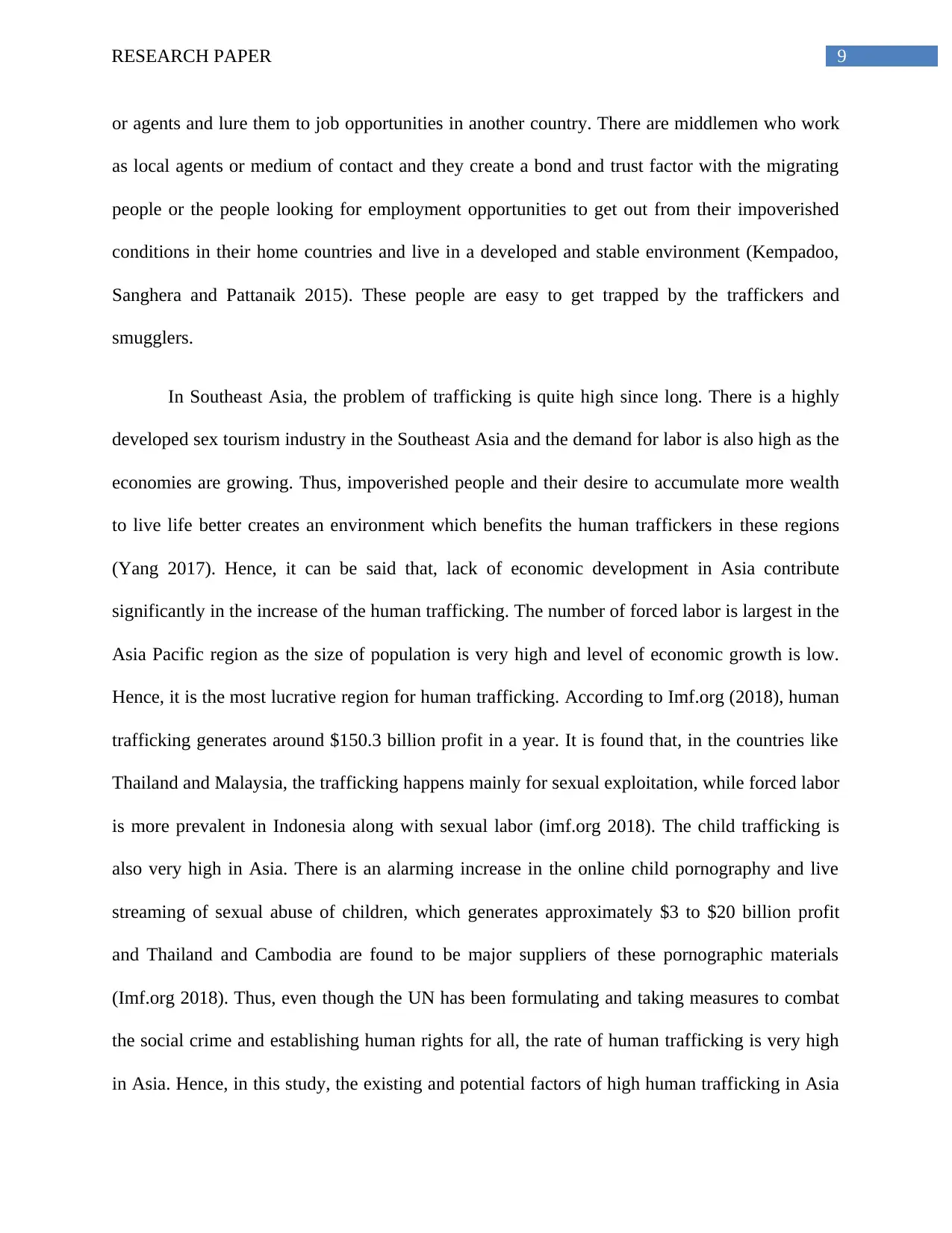
9RESEARCH PAPER
or agents and lure them to job opportunities in another country. There are middlemen who work
as local agents or medium of contact and they create a bond and trust factor with the migrating
people or the people looking for employment opportunities to get out from their impoverished
conditions in their home countries and live in a developed and stable environment (Kempadoo,
Sanghera and Pattanaik 2015). These people are easy to get trapped by the traffickers and
smugglers.
In Southeast Asia, the problem of trafficking is quite high since long. There is a highly
developed sex tourism industry in the Southeast Asia and the demand for labor is also high as the
economies are growing. Thus, impoverished people and their desire to accumulate more wealth
to live life better creates an environment which benefits the human traffickers in these regions
(Yang 2017). Hence, it can be said that, lack of economic development in Asia contribute
significantly in the increase of the human trafficking. The number of forced labor is largest in the
Asia Pacific region as the size of population is very high and level of economic growth is low.
Hence, it is the most lucrative region for human trafficking. According to Imf.org (2018), human
trafficking generates around $150.3 billion profit in a year. It is found that, in the countries like
Thailand and Malaysia, the trafficking happens mainly for sexual exploitation, while forced labor
is more prevalent in Indonesia along with sexual labor (imf.org 2018). The child trafficking is
also very high in Asia. There is an alarming increase in the online child pornography and live
streaming of sexual abuse of children, which generates approximately $3 to $20 billion profit
and Thailand and Cambodia are found to be major suppliers of these pornographic materials
(Imf.org 2018). Thus, even though the UN has been formulating and taking measures to combat
the social crime and establishing human rights for all, the rate of human trafficking is very high
in Asia. Hence, in this study, the existing and potential factors of high human trafficking in Asia
or agents and lure them to job opportunities in another country. There are middlemen who work
as local agents or medium of contact and they create a bond and trust factor with the migrating
people or the people looking for employment opportunities to get out from their impoverished
conditions in their home countries and live in a developed and stable environment (Kempadoo,
Sanghera and Pattanaik 2015). These people are easy to get trapped by the traffickers and
smugglers.
In Southeast Asia, the problem of trafficking is quite high since long. There is a highly
developed sex tourism industry in the Southeast Asia and the demand for labor is also high as the
economies are growing. Thus, impoverished people and their desire to accumulate more wealth
to live life better creates an environment which benefits the human traffickers in these regions
(Yang 2017). Hence, it can be said that, lack of economic development in Asia contribute
significantly in the increase of the human trafficking. The number of forced labor is largest in the
Asia Pacific region as the size of population is very high and level of economic growth is low.
Hence, it is the most lucrative region for human trafficking. According to Imf.org (2018), human
trafficking generates around $150.3 billion profit in a year. It is found that, in the countries like
Thailand and Malaysia, the trafficking happens mainly for sexual exploitation, while forced labor
is more prevalent in Indonesia along with sexual labor (imf.org 2018). The child trafficking is
also very high in Asia. There is an alarming increase in the online child pornography and live
streaming of sexual abuse of children, which generates approximately $3 to $20 billion profit
and Thailand and Cambodia are found to be major suppliers of these pornographic materials
(Imf.org 2018). Thus, even though the UN has been formulating and taking measures to combat
the social crime and establishing human rights for all, the rate of human trafficking is very high
in Asia. Hence, in this study, the existing and potential factors of high human trafficking in Asia
Paraphrase This Document
Need a fresh take? Get an instant paraphrase of this document with our AI Paraphraser
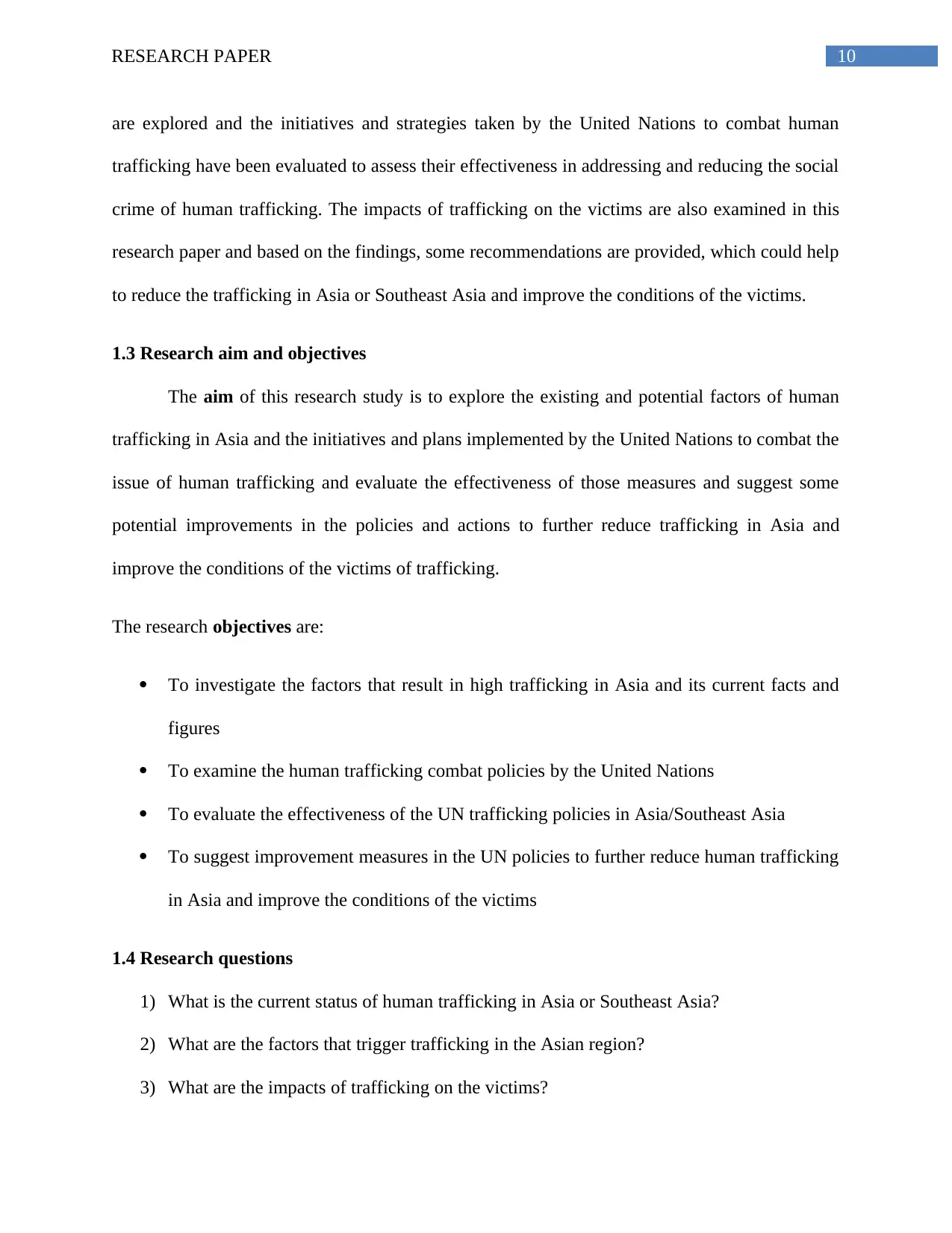
10RESEARCH PAPER
are explored and the initiatives and strategies taken by the United Nations to combat human
trafficking have been evaluated to assess their effectiveness in addressing and reducing the social
crime of human trafficking. The impacts of trafficking on the victims are also examined in this
research paper and based on the findings, some recommendations are provided, which could help
to reduce the trafficking in Asia or Southeast Asia and improve the conditions of the victims.
1.3 Research aim and objectives
The aim of this research study is to explore the existing and potential factors of human
trafficking in Asia and the initiatives and plans implemented by the United Nations to combat the
issue of human trafficking and evaluate the effectiveness of those measures and suggest some
potential improvements in the policies and actions to further reduce trafficking in Asia and
improve the conditions of the victims of trafficking.
The research objectives are:
To investigate the factors that result in high trafficking in Asia and its current facts and
figures
To examine the human trafficking combat policies by the United Nations
To evaluate the effectiveness of the UN trafficking policies in Asia/Southeast Asia
To suggest improvement measures in the UN policies to further reduce human trafficking
in Asia and improve the conditions of the victims
1.4 Research questions
1) What is the current status of human trafficking in Asia or Southeast Asia?
2) What are the factors that trigger trafficking in the Asian region?
3) What are the impacts of trafficking on the victims?
are explored and the initiatives and strategies taken by the United Nations to combat human
trafficking have been evaluated to assess their effectiveness in addressing and reducing the social
crime of human trafficking. The impacts of trafficking on the victims are also examined in this
research paper and based on the findings, some recommendations are provided, which could help
to reduce the trafficking in Asia or Southeast Asia and improve the conditions of the victims.
1.3 Research aim and objectives
The aim of this research study is to explore the existing and potential factors of human
trafficking in Asia and the initiatives and plans implemented by the United Nations to combat the
issue of human trafficking and evaluate the effectiveness of those measures and suggest some
potential improvements in the policies and actions to further reduce trafficking in Asia and
improve the conditions of the victims of trafficking.
The research objectives are:
To investigate the factors that result in high trafficking in Asia and its current facts and
figures
To examine the human trafficking combat policies by the United Nations
To evaluate the effectiveness of the UN trafficking policies in Asia/Southeast Asia
To suggest improvement measures in the UN policies to further reduce human trafficking
in Asia and improve the conditions of the victims
1.4 Research questions
1) What is the current status of human trafficking in Asia or Southeast Asia?
2) What are the factors that trigger trafficking in the Asian region?
3) What are the impacts of trafficking on the victims?
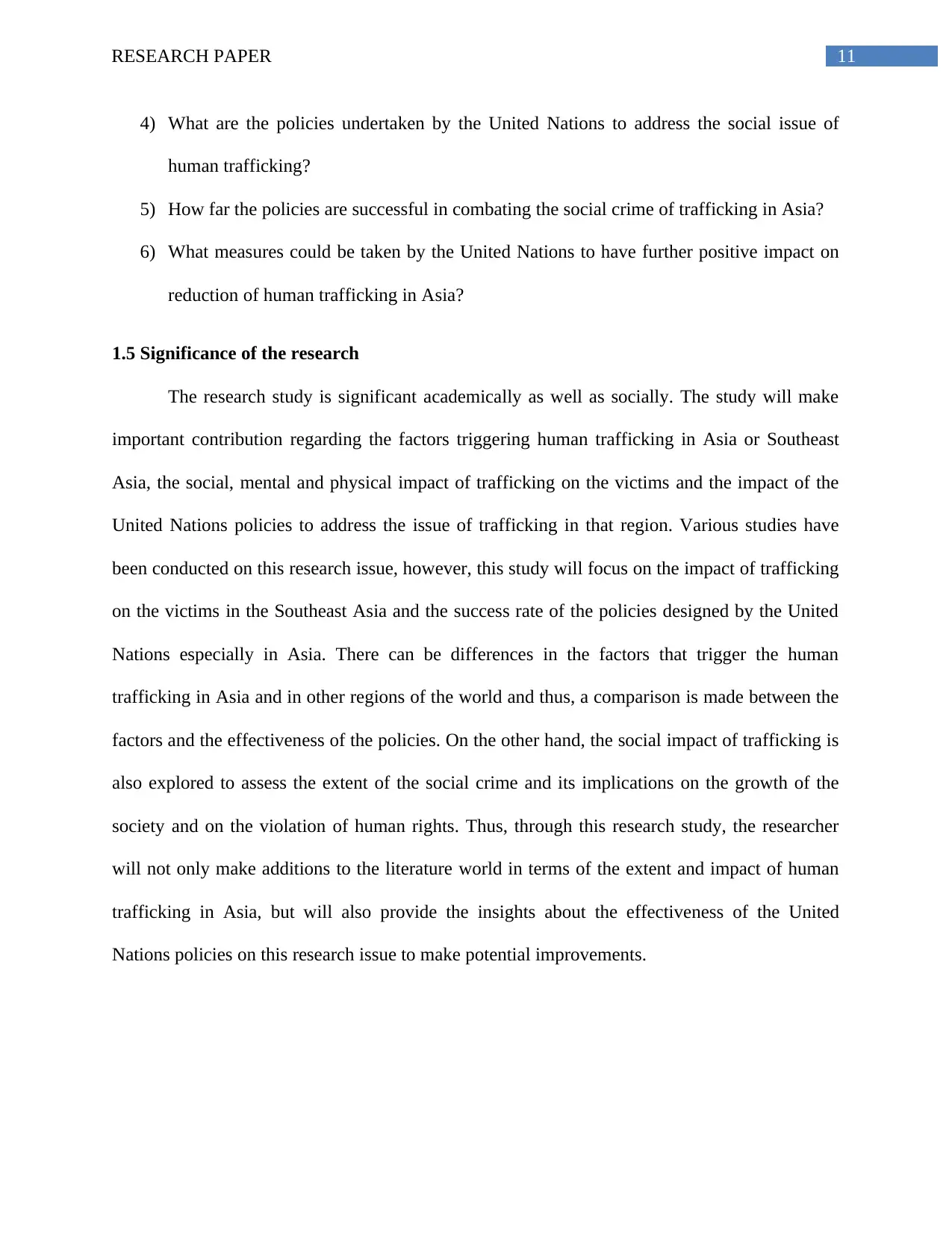
11RESEARCH PAPER
4) What are the policies undertaken by the United Nations to address the social issue of
human trafficking?
5) How far the policies are successful in combating the social crime of trafficking in Asia?
6) What measures could be taken by the United Nations to have further positive impact on
reduction of human trafficking in Asia?
1.5 Significance of the research
The research study is significant academically as well as socially. The study will make
important contribution regarding the factors triggering human trafficking in Asia or Southeast
Asia, the social, mental and physical impact of trafficking on the victims and the impact of the
United Nations policies to address the issue of trafficking in that region. Various studies have
been conducted on this research issue, however, this study will focus on the impact of trafficking
on the victims in the Southeast Asia and the success rate of the policies designed by the United
Nations especially in Asia. There can be differences in the factors that trigger the human
trafficking in Asia and in other regions of the world and thus, a comparison is made between the
factors and the effectiveness of the policies. On the other hand, the social impact of trafficking is
also explored to assess the extent of the social crime and its implications on the growth of the
society and on the violation of human rights. Thus, through this research study, the researcher
will not only make additions to the literature world in terms of the extent and impact of human
trafficking in Asia, but will also provide the insights about the effectiveness of the United
Nations policies on this research issue to make potential improvements.
4) What are the policies undertaken by the United Nations to address the social issue of
human trafficking?
5) How far the policies are successful in combating the social crime of trafficking in Asia?
6) What measures could be taken by the United Nations to have further positive impact on
reduction of human trafficking in Asia?
1.5 Significance of the research
The research study is significant academically as well as socially. The study will make
important contribution regarding the factors triggering human trafficking in Asia or Southeast
Asia, the social, mental and physical impact of trafficking on the victims and the impact of the
United Nations policies to address the issue of trafficking in that region. Various studies have
been conducted on this research issue, however, this study will focus on the impact of trafficking
on the victims in the Southeast Asia and the success rate of the policies designed by the United
Nations especially in Asia. There can be differences in the factors that trigger the human
trafficking in Asia and in other regions of the world and thus, a comparison is made between the
factors and the effectiveness of the policies. On the other hand, the social impact of trafficking is
also explored to assess the extent of the social crime and its implications on the growth of the
society and on the violation of human rights. Thus, through this research study, the researcher
will not only make additions to the literature world in terms of the extent and impact of human
trafficking in Asia, but will also provide the insights about the effectiveness of the United
Nations policies on this research issue to make potential improvements.
⊘ This is a preview!⊘
Do you want full access?
Subscribe today to unlock all pages.

Trusted by 1+ million students worldwide
1 out of 85
Related Documents
Your All-in-One AI-Powered Toolkit for Academic Success.
+13062052269
info@desklib.com
Available 24*7 on WhatsApp / Email
![[object Object]](/_next/static/media/star-bottom.7253800d.svg)
Unlock your academic potential
Copyright © 2020–2025 A2Z Services. All Rights Reserved. Developed and managed by ZUCOL.





